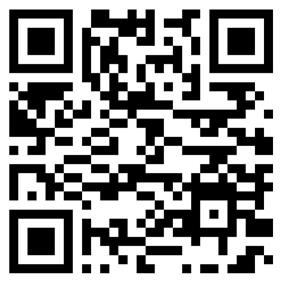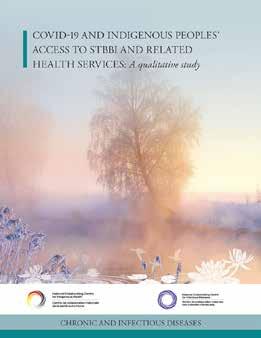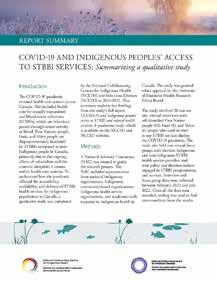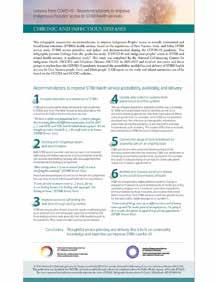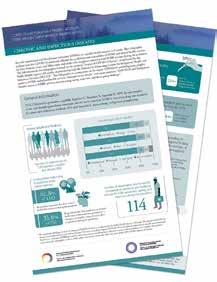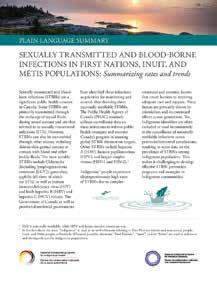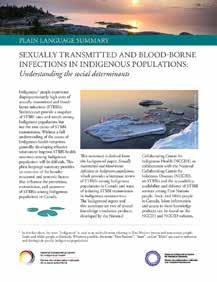This plain language summary provides an overview of the rates and trends of nationally notifiable STBBIs most common in First Nations, Inuit, and Métis populations. It is one of several knowledge 3 products jointly produced by the National Collaborating Centre for Indigenous Health (NCCIH) and the National Collaborating Centre for Infectious Diseases (NCCID) on STBBI prevalence and the accessibility, availability, and delivery of STBBI services among Indigenous Peoples in Canada. The information presented in this summary is derived from the background paper, Sexually transmitted and blood-borne infections in Indigenous populations, which provides a literature review of STBBIs among First Nations, Inuit, and Métis populations in Canada and ways of reducing STBBI transmission in Indigenous communities. More information and access to STBBI knowledge products can be found on the NCCIH and NCCID websites.
Chlamydia
There is a paucity of nationallevel surveillance data on the prevalence of Chlamydia among Indigenous populations in Canada. The PHAC last reported, in 2013, that the rate of Chlamydia was almost seven times higher among Indigenous adults compared to non-Indigenous adults. Regional surveillance data also showed high rates of Chlamydia among First Nations and Inuit populations. For example, high rates of Chlamydia were found among First Nations populations in Saskatchewan and Alberta. In 2007, 2012, and 2016, reported rates of Chlamydia, respectively, were 7.2, 6.8, and 5.2 times higher among First Nations populations in Saskatchewan than the corresponding rates for Canada. In Alberta, Chlamydia was the most commonly reported sexually transmitted infection (STI) among First Nations
populations over the 2007-2011 period, with rates increasing by 50% over this period.
Although recent Inuit-specific data are not available, evidence from predominantly Inuit regions showed similarly high rates of Chlamydia infection. Over the 2010-2015 period, the rate of laboratory-confirmed cases of Chlamydia in Nunavut was 3,791.2 per 100,000 population, compared to a national average of 325.0 per 100,000 population. Likewise, the incidence rate of Chlamydia infection in the Nunavik region of Quebec rose by more than 44% over the 2013-2017 period and was 18 times higher than in the rest of Quebec in 2017. In contrast, rates of Chlamydia among First Nations populations in the Atlantic provinces over the 2011-2015 period more closely mirrored that of the general population. Data pertaining to Métis peoples are unavailable.
3 Although HAV can be transmitted from one person to another through sexual activity, it is excluded from discussion here because it is primarily transmitted by ingesting contaminated food and drinking water.

Syphilis
Past studies have shown that Indigenous people may be disproportionately affected by syphilis due to risk factors such as involvement in sex work and illicit drug use. Nevertheless, syphilis rates have varied widely in Indigenous populations across Canada. Among First Nations in Saskatchewan, the rate of syphilis increased from a low of 0.0 per 100,000 in 2007, to 7.2 per 100,000 in 2012, and slightly decreased to 6.7 per 100,000 population in 2016. These rates were lower than the corresponding rates for the general Canadian population over this period. In Alberta, 50% of infectious syphilis cases reported over the 2018-2019 period were
among self-identified Indigenous people. In British Columbia, the proportion of infectious syphilis cases among individuals who selfidentified as Indigenous decreased annually from 8.8% in 2008 to 2.3% in 2017. However, national rates of syphilis generally have been rising across Canada and there is some emerging evidence from Saskatchewan, where there has been a 900% increase in the number of syphilis cases reported since 2019, that suggests rates may also be increasing alarmingly fast among some First Nations.
Rates of infectious syphilis are high in northern regions of the country. In 2017, Nunavut had the highest rate in Canada, with 234 cases of syphilis per 100,000 population, compared to only 11.2 per 100,000 population for Canada. Similarly high rates of infectious syphilis were also found in the Inuit region of Nunavik. Data pertaining to Métis peoples are unavailable.
HIV/AIDS
A diverse body of literature details the rates and trends of HIV in Indigenous populations; however, information about the prevalence of acquired immunodeficiency syndrome (AIDS) 4 in Indigenous populations is limited, primarily due to a tendency to report on HIV and AIDS collectively.5
The literature reveals that First Nations, Inuit, and Métis populations are disproportionately impacted by HIV. In 2020, Indigenous people comprised 18.2% of all new HIV infections in Canada, representing an increase of 3.5% since 2018, while the incidence rate of HIV was almost four times greater than the general population. Regional data also showed high rates of HIV among Indigenous populations. For example, in 2018, 50% of new HIV cases reported in Manitoba were among self-identified
4 AIDS is the advanced stage of HIV infection that can occur when HIV is left untreated. During this stage of HIV, the body’s immune system is so badly weakened that life expectancy without medication is only about one to three years.
5 The collective reporting of HIV and AIDS may be attributed to the fact that because HIV is now well treated, few people progress to AIDS.

Indigenous people. This rate represented a substantial increase in new HIV diagnoses among Indigenous populations reported in the province since 2006. First Nations people in Alberta and Saskatchewan also accounted for a disproportionately high percentage of new HIV diagnoses. In contrast, no new HIV cases were reported in Nunavut over the 2007-2014 period. Data pertaining to Métis peoples are unavailable.
UNAIDS, a joint United Nations programme on HIV/AIDS, established a framework in 2014 for eliminating AIDS globally, with targets set at 90-90-90.6 In 2023, these targets were revised to 95-95-95. Canada has routinely reported on its progress in meeting these targets and is close
to achieving the 90-90-90 targets; however, more work is needed to achieve the 95-95-95 targets. Data on how well the country is meeting these targets with respect to First Nations, Inuit, and Métis populations are sparse. Regional data showed that the targets have been more difficult to meet for First Nations populations in Saskatchewan and Alberta but less difficult for Indigenous people in federal corrections facilities, suggesting that targets may be better met in an institutional setting where food, shelter, and potentially STBBI services and harm reduction programs may be more accessible.
The difficulties in achieving UNAIDs targets in relation to Indigenous populations may be
attributed to barriers that hinder Indigenous people’s access to care and/or their willingness and capacity to adhere to treatment. This includes injection drug use, which is considered the primary exposure pathway for HIV among Indigenous populations, and culturally unsafe services or treatment. Recent studies showing that Indigenous people may be at increased risk of not achieving an undetectable viral load and of experiencing a viral rebound 7 lend some support to this finding.8 Although recent data on the prevalence of AIDS among Indigenous populations are not available, given the challenges Canada faces in meeting its global targets, it is likely that Indigenous people will be over-represented in AIDS cases.
6 These targets refer to the proportion of the population who are aware of their HIV status, the proportion of diagnosed people who are receiving antiretroviral treatment, and the proportion of people on treatment who have achieved viral suppression by the target date. In 2014, these targets were set at 90-90-90 to be achieved by 2020; the recently released 95-95-95 targets were slated to be achieved by 2030.
7 When medication is taken as prescribed, the presence of the virus in the body can be reduced to levels considered undetectable (undetectable viral load). At this level, HIV is no longer highly infectious and cannot be spread to others. However, if medication is interrupted, the presence of the virus (viral load) increases, increasing the infectiousness of HIV.
8 See for example, Hosein (2017). Exploring viral suppression rates among some Indigenous people who started ART. CATIE News, January 12; Kerkerian et al. (2018). Attrition across the HIV cascade of care among a diverse cohort of women living with HIV in Canada. Journal of Acquired Immune Deficiency Syndrome, 79(2), 226-236; and Palmer et al. (2018). Viral suppression and viral rebound among young adults living with HIV in Canada. Medicine, 97(22), e10562.
5

Conclusion
The statistics described in this summary provide a snapshot of STBBI rates and trends in Indigenous populations across Canada. This snapshot reveals particularly high rates of STBBIs for select First Nations and Inuit populations. Rates of STBBIs that are primarily transmitted through sexual activity such as syphilis, gonorrhea, and Chlamydia appear to be on the rise. Since these STBBIs can be transmitted from mothers to infants during childbirth, increases in STBBI among Indigenous women may also increase infection among infants, with potentially harmful health consequences in the long term.
The paucity of national-level data on STBBIs among Indigenous populations is problematic. Stale data have the potential to hinder
the development of effective solutions for improving STBBI health outcomes for Indigenous people. This surveillance gap needs to be addressed through the consistent application of Indigenous identifiers in the collection of STBBI data across all federal, provincial, and territorial jurisdictions. It is important to note, however, that statistics alone do not tell the full story of the broader structural and systemic contexts facing Indigenous populations. To fully understand the rates and trends of STBBIs and support effective solutions among these populations, greater understanding of the intersecting factors that influence Indigenous peoples’ health and well-being, generally, is required.
7

